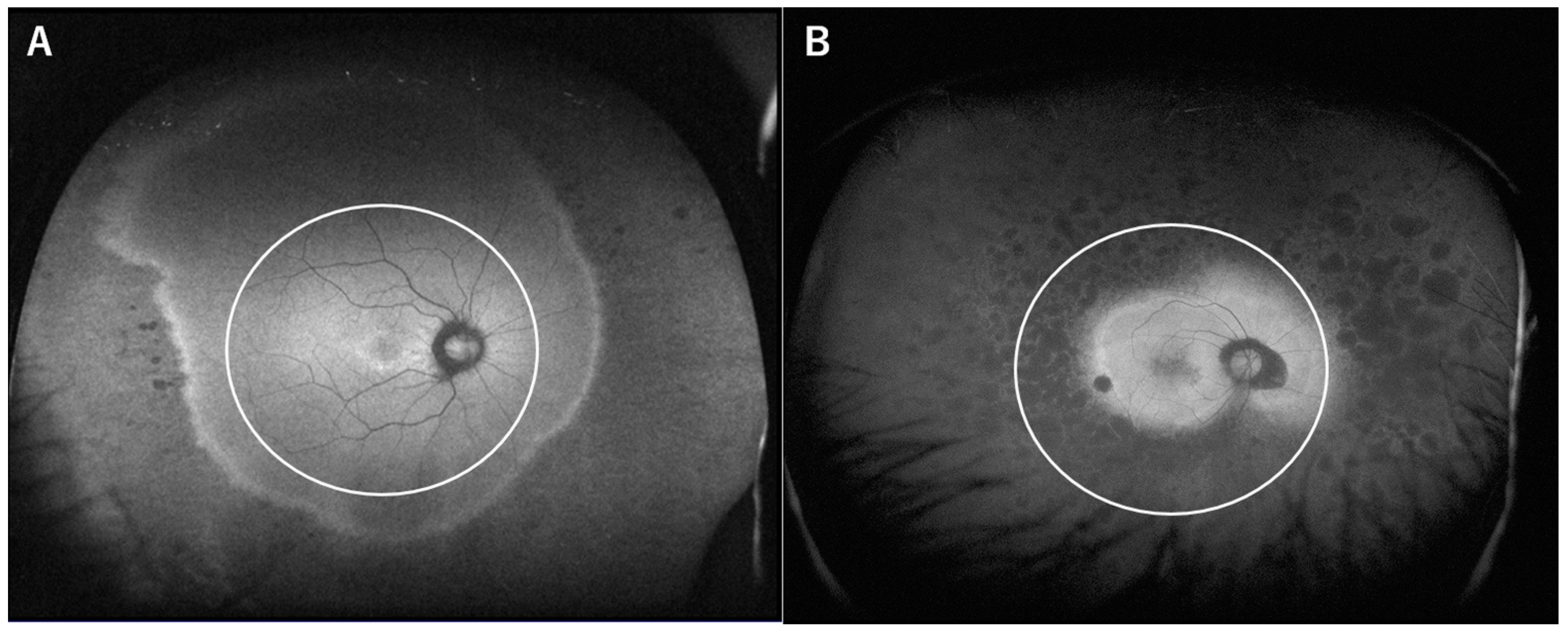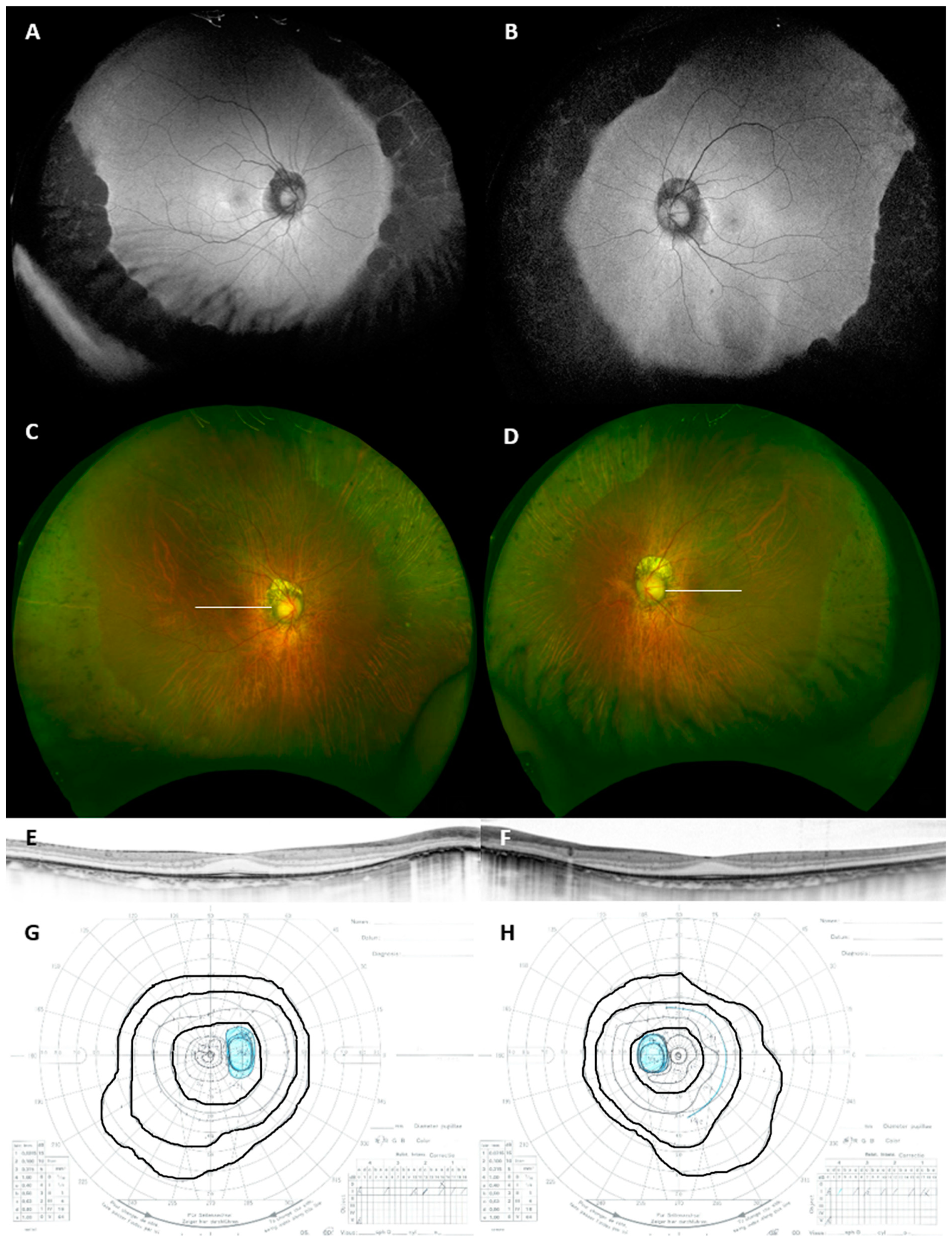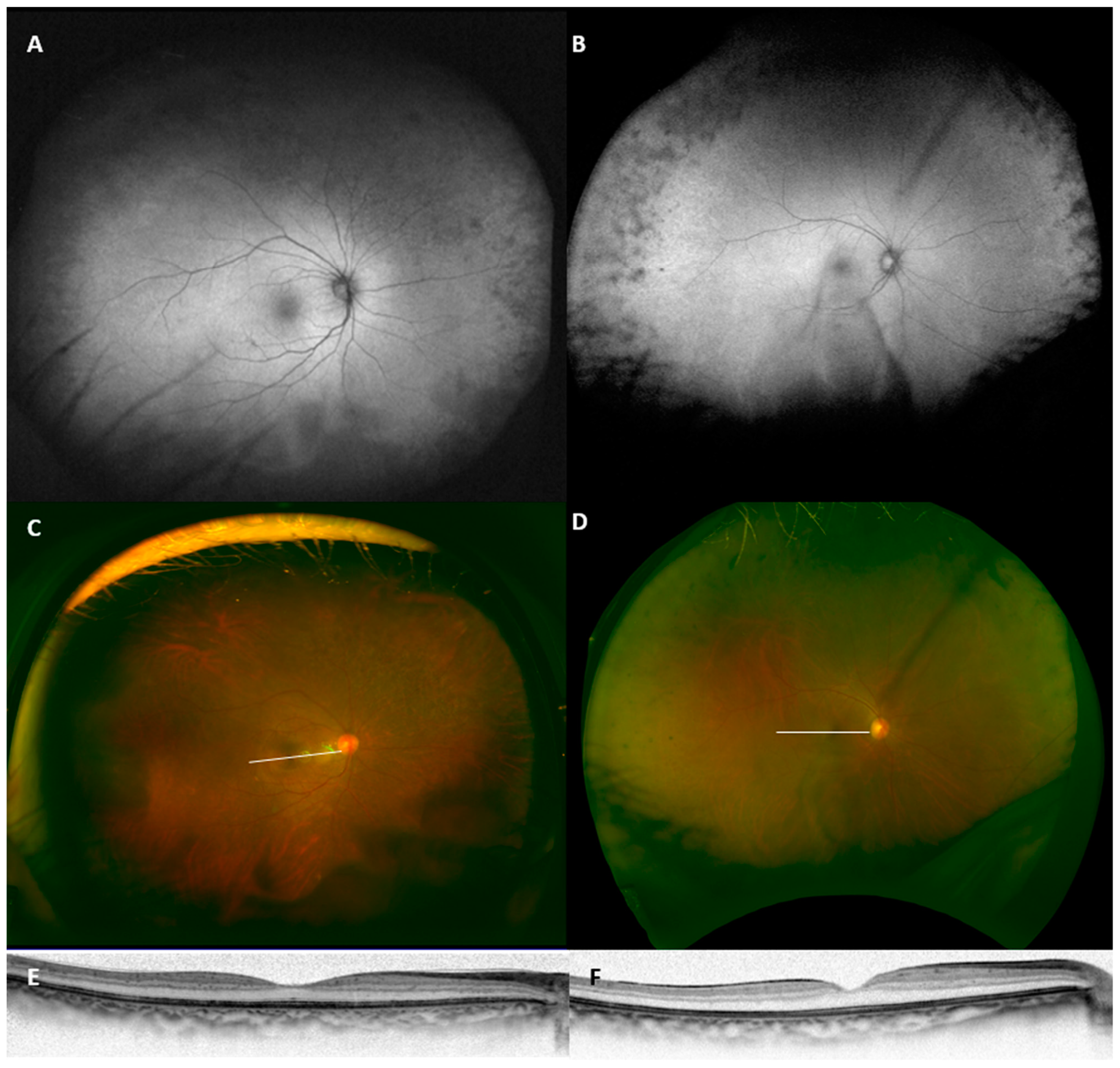Clinical Characteristics, Differential Diagnosis and Genetic Analysis of Concentric Retinitis Pigmentosa
Abstract
1. Introduction
2. Materials and Methods
3. Results
4. Discussion
Author Contributions
Funding
Institutional Review Board Statement
Informed Consent Statement
Data Availability Statement
Conflicts of Interest
References
- Verbakel, S.K.; van Huet, R.A.C.; Boon, C.J.F.; den Hollander, A.I.; Collin, R.W.J.; Klaver, C.C.W.; Hoyng, C.B.; Roepman, R.; Klevering, B.J. Non-syndromic retinitis pigmentosa. Prog. Retin. Eye Res. 2018, 66, 157–186. [Google Scholar] [CrossRef]
- Quinn, N.; Csincsik, L.; Flynn, E.; Curcio, C.A.; Kiss, S.; Sadda, S.R.; Hogg, R.; Peto, T.; Lengyel, I. The clinical relevance of visualising the peripheral retina. Prog. Retin. Eye Res. 2019, 68, 83–109. [Google Scholar] [CrossRef]
- Pichi, F.; Abboud, E.B.; Ghazi, N.G.; Khan, A.O. Fundus autofluorescence imaging in hereditary retinal diseases. Acta Ophthalmol. 2018, 96, e549–e561. [Google Scholar] [CrossRef]
- Oishi, A.; Miyata, M.; Numa, S.; Otsuka, Y.; Oishi, M.; Tsujikawa, A. Wide-field fundus autofluorescence imaging in patients with hereditary retinal degeneration: A literature review. Int. J. Retin. Vitr. 2019, 5, 23. [Google Scholar] [CrossRef] [PubMed]
- Grover, S.; Fishman, G.A.; Brown, J., Jr. Patterns of visual field progression in patients with retinitis pigmentosa. Ophthalmology 1998, 105, 1069–1075. [Google Scholar] [CrossRef]
- Milam, A.H.; De Castro, E.B.; Smith, J.E.; Tang, W.X.; John, S.K.; Gorin, M.B.; Stone, E.M.; Aguirre, G.D.; Jacobson, S.G. Concentric retinitis pigmentosa: Clinicopathologic correlations. Exp. Eye Res. 2001, 73, 493–508. [Google Scholar] [CrossRef]
- Kaufman, S.J.; Goldberg, M.F.; Orth, D.H.; Fishman, G.A.; Tessler, H.; Mizuno, K. Autosomal dominant vitreoretinochoroidopathy. Arch Ophthalmol. 1982, 100, 272–278. [Google Scholar] [CrossRef]
- Yardley, J.; Leroy, B.P.; Hart-Holden, N.; Lafaut, B.A.; Loeys, B.; Messiaen, L.M.; Perveen, R.; Reddy, M.A.; Bhattacharya, S.S.; Traboulsi, E.; et al. Mutations of VMD2 splicing regulators cause nanophthalmos and autosomal dominant vitreoretinochoroidopathy (ADVIRC). Investig. Ophthalmol. Vis. Sci. 2004, 45, 3683–3689. [Google Scholar] [CrossRef] [PubMed]
- Oishi, M.; Oishi, A.; Gotoh, N.; Ogino, K.; Higasa, K.; Iida, K.; Makiyama, Y.; Morooka, S.; Matsuda, F.; Yoshimura, N. Comprehensive molecular diagnosis of a large cohort of Japanese retinitis pigmentosa and usher syndrome patients by next-generation sequencing. Investig. Ophthalmol. Vis. Sci. 2014, 55, 7369–7375. [Google Scholar] [CrossRef]
- Oishi, M.; Oishi, A.; Gotoh, N.; Ogino, K.; Higasa, K.; Iida, K.; Makiyama, Y.; Morooka, S.; Matsuda, F.; Yoshimura, N. Next-generation sequencing-based comprehensive molecular analysis of 43 Japanese patients with cone and cone-rod dystrophies. Mol. Vis. 2016, 22, 150–160. [Google Scholar]
- Numa, S.; Oishi, A.; Higasa, K.; Oishi, M.; Miyata, M.; Hasegawa, T.; Ikeda, H.O.; Otsuka, Y.; Matsuda, F.; Tsujikawa, A. EYS is a major gene involved in retinitis pigmentosa in Japan: Genetic landscapes revealed by stepwise genetic screening. Sci. Rep. 2020, 10, 20770. [Google Scholar] [CrossRef] [PubMed]
- Coussa, R.G.; Basali, D.; Maeda, A.; DeBenedictis, M.; Traboulsi, E.I. Sector retinitis pigmentosa: Report of ten cases and a review of the literature. Mol. Vis. 2019, 25, 869–889. [Google Scholar]
- Xiao, T.; Xu, K.; Zhang, X.; Xie, Y.; Li, Y. Sector retinitis pigmentosa caused by mutations of the RHO gene. Eye (Lond.) 2019, 33, 592–599. [Google Scholar] [CrossRef]
- Snead, M.P.; Yates, J.R. Clinical and molecular genetics of Stickler syndrome. J. Med. Genet. 1999, 36, 353–359. [Google Scholar]
- Meredith, S.P.; Richards, A.J.; Flanagan, D.W.; Scott, J.D.; Poulson, A.V.; Snead, M.P. Clinical characterisation and molecular analysis of Wagner syndrome. Br. J. Ophthalmol. 2007, 91, 655–659. [Google Scholar] [CrossRef] [PubMed]
- Witmer, M.T.; Kozbial, A.; Daniel, S.; Kiss, S. Peripheral autofluorescence findings in age-related macular degeneration. Acta Ophthalmol. 2012, 90, e428–e433. [Google Scholar] [CrossRef]
- Tan, C.S.; Heussen, F.; Sadda, S.R. Peripheral autofluorescence and clinical findings in neovascular and non-neovascular age-related macular degeneration. Ophthalmology 2013, 120, 1271–1277. [Google Scholar] [CrossRef]
- Domalpally, A.; Clemons, T.E.; Danis, R.P.; Sadda, S.R.; Cukras, C.A.; Toth, C.A.; Friberg, T.R.; Chew, E.Y. Peripheral retinal changes associated with age-related macular degeneration in the Age-Related Eye Disease Study 2: Age-Related Eye Disease Study 2 Report Number 12 by the Age-Related Eye Disease Study 2 Optos PEripheral RetinA (OPERA) Study Research Group. Ophthalmology 2017, 124, 479–487. [Google Scholar] [CrossRef]
- Burian, H.M.; Burns, C.A. Ocular changes in myotonic dystrophy. Am. J. Ophthalmol. 1967, 63, 22–34. [Google Scholar] [CrossRef][Green Version]
- Kimizuka, Y.; Kiyosawa, M.; Tamai, M.; Takase, S. Retinal changes in myotonic dystrophy. Clinical and follow-up evaluation. Retina 1993, 13, 129–135. [Google Scholar] [CrossRef]
- Sarks, J.; Penfold, P.; Liu, H.; Sarks, S.; Killingsworth, M.; Horowitz, G. Retinal changes in myotonic dystrophy: A clinicomorphological study. Aust. N. Z. J. Ophthalmol. 1985, 13, 19–36. [Google Scholar] [CrossRef]
- Abed, E.; D’Amico, G.; Rossi, S.; Perna, A.; Bianchi, M.L.E.; Silvestri, G. Spectral domain optical coherence tomography findings in myotonic dystrophy. Neuromuscul. Disord. Nmd. 2020, 30, 144–150. [Google Scholar] [CrossRef] [PubMed]
- Kersten, H.M.; Roxburgh, R.H.; Danesh-Meyer, H.V. Ophthalmic manifestations of inherited neurodegenerative disorders. Nat. Rev. Neurol. 2014, 10, 349–362. [Google Scholar] [CrossRef]




| Sex | Age | Onset Age | Symptom | Visual Acuity | Scotopic ERG | Photopic ERG | Detected Mutation | Comorbidities | |
|---|---|---|---|---|---|---|---|---|---|
| #1 * | Woman | 29 | 22 | photopsia | 1.2 | normal | normal | none | Renal dysfunction |
| #2 * | Woman | 36 | 28 | blurred vision at evening | 1.2 | non recordable | normal | none | |
| #3 | Woman | 41 | diagnosed at 38 | none | 1.2 | unavailable | unavailable | unavailable | Interstitial pneumonia |
| #4 | Woman | 47 | unclear | unclear | 0.8 | reduced amplitude | reduced amplitude | none | Myotonic dystrophy, Diabetes |
| #5 | Woman | 50 | 20s | blurred vision and floaters | 1.2 | unavailable | unavailable | unavailable | Myotonic dystrophy |
| #6 | Man | 64 | 58 | blurred vision at evening | 1.0 | reduced amplitude | reduced amplitude | none | Intervertebral disc hernia |
| #7 | Man | 66 | unclear | unclear | 1.2 | reduced amplitude | reduced amplitude | unavailable | Angina pectoris |
| #8 | Woman | 69 | diagnosed at 62 | none | 1.2 | unavailable | unavailable | EYS (c.2528G>A: p.G843E, homozygous) | |
| #9 | Man | 70 | 40s | nyctalopia | 1.5 | reduced amplitude | normal | none | |
| #10 | Woman | 71 | diagnosed at 60 | none | 1.0 | reduced amplitude | reduced amplitude | unavailable | Thyroid gland cancer |
| #11 | Woman | 74 | 50s | nyctalopia | 1.2 | reduced amplitude | reduced amplitude | none | Diabetes |
| #12 | Woman | 75 | 58 | stumbling (visual field restriction) | 0.9 | reduced amplitude | reduced amplitude | none | |
| #13 | Man | 79 | 40s | nyctalopia | 0.9 | reduced amplitude | reduced amplitude | none | |
| #14 | Man | 87 | diagnosed at 66 | none | 1.0 | reduced amplitude | reduced amplitude | RP9 (c.509A>G: p.D170G) | Diabetes, Coronary artery occlusion |
| Concentric RP (n = 14) | Typical RP (n = 14) | p-Value | Reference In-House Normal Range | |
|---|---|---|---|---|
| Age (years) | 61.3 ± 17.6 | 61.4 ± 17.1 | 0.99 | |
| Sex (Man/Woman) | 5/9 | 5/9 | 1.00 | |
| Visual acuity (logMAR) | −0.04 ± 0.07 | 0.32 ± 0.60 | 0.047 | |
| HFA 10-2 MD (dB) | −3.1 ± 3.0 | −18.1 ± 11.8 | <0.001 | |
| Central threshold (dB) | 33.7 ± 2.1 | 27.8 ± 9.6 | 0.04 | |
| Dark adapted 0.01 ERG b-wave (µV) | 28.9 ± 20.5 | 6.3 ± 11.9 | 0.002 | 81–128 |
| Dark adapted 3.0 ERG a-wave (µV) | 55.9 ± 34.6 | 15.0 ± 17.4 | 0.003 | 67–281 |
| Dark adapted 3.0 ERG b-wave (µV) | 102.1 ± 39.2 | 23.5 ± 23.3 | <0.001 | 139–361 |
| Light adapted 3.0 ERG b-wave (µV) | 59.0 ± 23.8 | 12.1 ± 9.9 | <0.001 | 83–259 |
| Central retinal thickness (µm) | 215.6 ± 42.0 | 218.8 ± 116.0 | 0.92 | |
| Ellipsoid zone width (µm) | 7630 ± 1284 | 2646 ± 2488 | <0.001 |
Publisher’s Note: MDPI stays neutral with regard to jurisdictional claims in published maps and institutional affiliations. |
© 2021 by the authors. Licensee MDPI, Basel, Switzerland. This article is an open access article distributed under the terms and conditions of the Creative Commons Attribution (CC BY) license (http://creativecommons.org/licenses/by/4.0/).
Share and Cite
Nakahara, M.; Oishi, A.; Miyata, M.; Ikeda, H.O.; Hasegawa, T.; Numa, S.; Otsuka, Y.; Oishi, M.; Matsuda, F.; Tsujikawa, A. Clinical Characteristics, Differential Diagnosis and Genetic Analysis of Concentric Retinitis Pigmentosa. Life 2021, 11, 260. https://doi.org/10.3390/life11030260
Nakahara M, Oishi A, Miyata M, Ikeda HO, Hasegawa T, Numa S, Otsuka Y, Oishi M, Matsuda F, Tsujikawa A. Clinical Characteristics, Differential Diagnosis and Genetic Analysis of Concentric Retinitis Pigmentosa. Life. 2021; 11(3):260. https://doi.org/10.3390/life11030260
Chicago/Turabian StyleNakahara, Mei, Akio Oishi, Manabu Miyata, Hanako Ohashi Ikeda, Tomoko Hasegawa, Shogo Numa, Yuki Otsuka, Maho Oishi, Fumihiko Matsuda, and Akitaka Tsujikawa. 2021. "Clinical Characteristics, Differential Diagnosis and Genetic Analysis of Concentric Retinitis Pigmentosa" Life 11, no. 3: 260. https://doi.org/10.3390/life11030260
APA StyleNakahara, M., Oishi, A., Miyata, M., Ikeda, H. O., Hasegawa, T., Numa, S., Otsuka, Y., Oishi, M., Matsuda, F., & Tsujikawa, A. (2021). Clinical Characteristics, Differential Diagnosis and Genetic Analysis of Concentric Retinitis Pigmentosa. Life, 11(3), 260. https://doi.org/10.3390/life11030260







